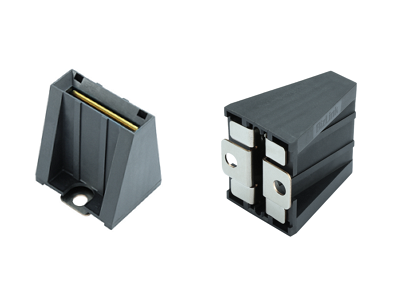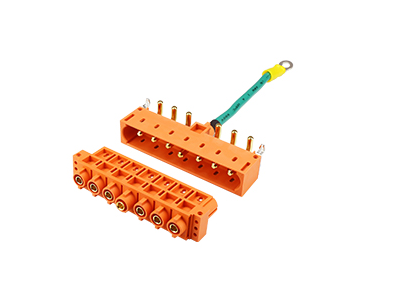- Home
- News & Events
- News
- Important Factors to Consider When Selecting High-Power Connectors for Data Centers
November 11, 2021
<< Back
Important Factors to Consider When Selecting High-Power Connectors for Data Centers
High-power connectors play a significant role in the delivery of high-reliability performance and connectivity across an extensive range of applications. Among those include data centers, which are responsible for managing and storing a wealth of information and data that help drive operations globally each day. Because these types of connectors are designed to meet specific application needs, here are the most important factors to consider when selecting high-power connectors for data centers.
Electrical Requirements
When choosing a high-power connector, it is important to first carefully review whether its electrical and technical specifications meet the requirements necessary for your data center to perform optimally. One crucial spec to pay close attention to is the connector’s power rating, including maximum voltage and amperage that it is designed to handle. It is also critical to determine the connector’s maximum operating temperature since an increase in temperature above the maximum will reduce the rated power for the connector. This derating factor will help determine how to specify the proper power rating for a given application in the data center. In general terms, connectors should be specified so that their maximum power rating is higher than the environmental and electrical characteristics they are likely to be subjected to in the data center equipment. This is known as the design margin or the safety margin, which will have the effect of increasing the connector’s reliability and performance by not subjecting it to electrical overstress. For example, if an engineer needs to select a connector that can be used for an application rated at 380Vac/25A – peak rating of 380Vrms is about 538Vpeak and at least 125% of 25A which is referred from NEC(National Electrical Code) – it is recommended that the connector specification be greater than 600V and 32A, (representing 125% of the peak power rating).

The BzKlip300 Series High-Power DC Busbar Connector is especially designed for power distribution in data center servers, hyperscale computing architectures, modular power supplies, rack-mounted high-power systems, and industrial applications
Mechanical Requirements
Equally as important as the electrical specifications of any high-power connector are its mechanical characteristics. This includes the device’s dimensions, measurements, and design features – all of which pose certain limitations that can affect installation of the connector and its performance within the data center application. For this reason, it is imperative to consider the connector’s form factor and profile to determine whether it is compatible with the data center’s configuration. High-power connectors are required to handle high voltage and high current electrical loads, which in turn requires that the connections have adequate separation from each other, and from other devices in the system to prevent unwanted electrical contact or interference. Further, the cables connected to these connectors should be properly specified to handle the maximum rated voltage and current of the connector, using a similar design margin, or derating factor to specify the cables. For example, a 50A connector would require a minimum cable size of 8AWG, whereas a 32A connector would have a minimum cable requirement for a 10AWG cable. In addition, the connector’s contacts on the printed circuit board (PCB) need to be specified for the maximum power load, with adequate derating. It is also important to consider how the connector will be attached to the cable and the PCB – whether it be via screw, soldering, or the use of a lock function.Quality Assurance
After the mechanical requirements are assessed, the next step is to determine whether the high-power connector in consideration has undergone extensive testing and quality assurance to prove that it satisfies the most stringent safety standards necessary for the data center to operate at optimum performance. Depending on the specific connector application within the data center, different safety standards can apply, both for the connector as a component, as well as for the overall circuit and system in which it is installed. Examples include materials used, blade/prong configuration, current rating, and whether they have a locking feature. Also, safety standards such as UL1977/EN61984 may apply for connectors in data, signal, and power applications. Because the field environment in which the data center systems operate will also affect the reliability and functionality of the connector, especially over the course of its life cycle, some indicated tests are required to satisfy those differing environmental conditions. Examples of such tests include high humidity tests, which are required for applications requiring a waterproof function, or corrosive tests, which are mandatory for high pollution environments. The connector materials themselves need to adhere to standards for flammability (ex: UL94 V0 or V2) and may need to be certified as halogen-free or RoHS-compliant.
BizLink's 745-07A/07B/07F/07G Series AC High-Power Whip Connectors, with maximum 32A/10AWG and 50A/8AWG cables, are designed for AC inputs for power shelves of standardized servers in data centers.
Other Characteristics and Features
The final step for selecting a high-power connector for a data center is to identify any remaining key characteristics and features that will influence or affect the application design. For example, the basic standards of UL1977/EN61984/EIA-364 include requirements for temperature, contact resistance, current de-rating, and they detail the testing procedures and criteria for these applications. These include cost savings, flexibility in assembly, and ease of maintenance. For example, some questions to be addressed are:- Is this connector compatible with a hot-swappable system, meaning that the connector can be removed and replaced without shutting down or rebooting the data center?
- Is the connector type suitable for a wide range of applications?
- Depending on the operating environment, does the connector need a waterproof rating?
- Is a connector locking feature required?
- How will both the highest and lowest ambient temperature affect the connector's performance?